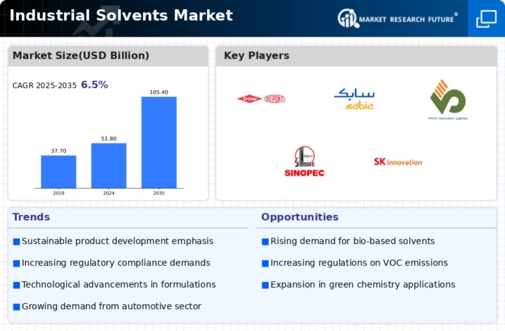Market Trends
Key Emerging Trends in the Industrial Solvents Market
The industrial solvents market is witnessing notable trends driven by various factors influencing demand, supply, and consumption patterns. One prominent trend is the growing emphasis on sustainable and eco-friendly solvents. With increasing environmental concerns and regulations, industries are shifting towards solvents that have minimal environmental impact and lower toxicity levels. This shift is primarily fueled by stringent regulations imposed by governments globally to reduce volatile organic compound (VOC) emissions, prompting manufacturers to innovate and develop greener alternatives. Consequently, there is a rising demand for bio-based solvents derived from renewable sources such as plant oils, corn, and soybeans.
The growth of the industrial solvents market is expected to create new opportunities
Another significant trend is the expanding application scope of industrial solvents across diverse industries. Traditionally, solvents have been extensively used in sectors like paints and coatings, pharmaceuticals, and chemical processing. However, the growing need for advanced cleaning agents, degreasers, and extraction solvents has led to their adoption in industries such as electronics, automotive, and aerospace. Additionally, solvents are increasingly utilized in niche applications like precision cleaning in semiconductor manufacturing and as carriers in drug delivery systems, further broadening their market reach.
Moreover, technological advancements are driving innovation in the industrial solvents market. Companies are investing in research and development to enhance solvent performance, efficiency, and safety. Advanced solvent formulations are being developed to meet specific industry requirements, such as high purity solvents for electronics manufacturing and low-residue solvents for pharmaceutical applications. Furthermore, the integration of automation and digitalization in solvent production processes is streamlining operations and improving product consistency and quality.
Furthermore, globalization and economic growth are influencing market dynamics in the industrial solvents sector. Rapid industrialization in emerging economies, particularly in Asia-Pacific and Latin America, is fueling the demand for solvents across various end-user industries. The expansion of manufacturing activities, coupled with urbanization and infrastructure development, is driving the consumption of solvents for applications such as coatings, adhesives, and lubricants. Additionally, increasing disposable incomes and changing lifestyles are boosting demand for consumer goods, further stimulating solvent usage in manufacturing processes.
On the other hand, the industrial solvents market is facing challenges related to raw material availability and price volatility. Many solvents are derived from petroleum feedstocks, making them susceptible to fluctuations in crude oil prices. Moreover, geopolitical tensions and supply chain disruptions can impact the availability and cost of raw materials, thereby affecting solvent production and pricing. To mitigate these challenges, manufacturers are exploring alternative feedstocks and investing in supply chain resilience strategies.
Furthermore, regulatory compliance remains a key concern for companies operating in the industrial solvents market. Strict environmental regulations, such as REACH (Registration, Evaluation, Authorization and Restriction of Chemicals) in Europe and EPA (Environmental Protection Agency) regulations in the United States, govern the use and disposal of solvents. Compliance with these regulations necessitates investment in sustainable practices, waste management systems, and product stewardship initiatives. Companies that fail to adhere to regulatory requirements risk facing penalties, litigation, and reputational damage.








Leave a Comment